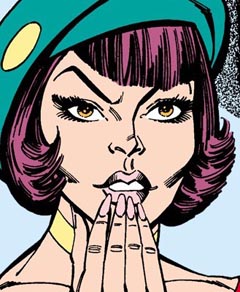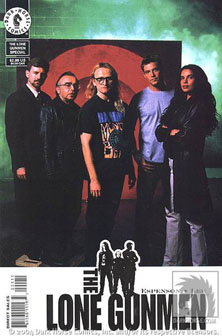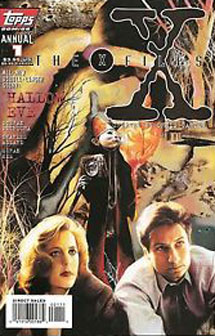The 41 regular issues of the Topps “X-Files” comics featured many Monster of the Month standalones, plus a handful of issues that felt like mythology episodes (mostly during the Stefan Petrucha run) and one Scully character piece (“N.D.E.”). One notably missing style of “X-Files” story is the comedic piece. But the special issues – two annuals, three digests, one graphic novel and three weirdly numbered issues (Issue -1, Issue -2 and Issue ½), plus Dark Horse’s “Lone Gunmen” one-shot – rectify this oversight, as several of these stories are whimsical in tone.
Those that don’t aim for chuckles tend to be deeper meditations than are found in the regular series. Essentially, the greater page count allows these stories to breathe more, making this batch of issues something that shouldn’t be overlooked by fans.
My favorite of the bunch is “Hallow Eve” (Annual 1, 1995) by Petrucha. Rather than the Halloween story suggested by the title, it chronicles an archaeologist’s supposed uncovering of the bones of “Eve,” the original human. A ghost story incorporates a campus urban legend, a medium a la “The Conjuring,” a “Scooby Doo” ending (which I’m not so fond of), a tragic villain and a touching reappearance of the ghost of Scully’s dad.
Petrucha’s “Dead to the World” (Digest 2, 1996) is about an eccentric and cocky villain who has figured out how to live forever by killing people and ingesting their adrenal glands. It’s ironic to note that he has Scully in his clutches but does not realize that according to one interpretation of “X-Files” lore (see the episodes “Clyde Bruckman’s Final Repose” and “Tithonus”), she is destined to live forever herself.
“AfterFlight” (1997) rounds out a trilogy of long-form masterpieces by Petrucha. As a “graphic novel,” this is the longest single-issue story published by Topps (slightly longer than an annual, which itself is double the length of a standard 24-page issue). As he touches upon the tragic nature of Alzheimer’s, the author also tells a sweet and fun story about an old man who aims to get his father’s ancient flying machine – which may, of course, have alien influence behind it — up and running.
“Big Foot, Warm Heart” (Digest 1, 1995) is a comparative misfire from Petrucha. Rather than a true Sasquatch, the title character is just a mountain gorilla – a rare, but certainly not unheard of, animal. This tale is a direct riff on “The Most Dangerous Game,” as an eccentric island-dwelling rich guy hunts rare animals and ultimately – of course – Mulder and Scully. I get a sense that Petrucha was somewhat rushed on this entry.
John Rozum’s stories tend to be more straightforward than Petrucha’s, but they’re not without merit. “E.L.F.s” (Annual 2, 1996) is a character study of a doctor who believes his brain is being controlled by radio waves. With the right actor, this could’ve played as a classic tragi-comic episode. That tone works in comic form, too, as I chuckled at the way the doctor wallpapers his house with tinfoil (nicely rendered by Gordon Purcell) and insists on wearing tinfoil underwear.

Rozum’s “Scape Goats” (Digest 3, 1996) is similar to “AfterFlight” in that a fairly standard family murder yarn is hijacked and given a spiritual dimension by the presence of an alien. In this case, the alien is known locally in Puerto Rico as a “chupacabras” (the “s” is not a pluralization). The similarly named El Chupacabra was also the monster in Season 4’s “El Mundo Gira,” which aired a few months after this digest was published.
While the graphic novel, annuals and digests are longer than standard comics, the three weirdly numbered issues are shorter than regular issues but still fun reads. Petrucha’s “Tiptoe through the Tulpa” (Issue ½, a Wizard special, 1996) is the best of these, chronicling a woman who manipulates the apparition of her comatose son. Petrucha’s “Trick of the Light” (Issue -1, 1996) and “The Pit” (the first part of Issue -2, 1996) are throwaway entries; there just aren’t enough pages to do justice to an artist/kidnapper or a haunted mining tunnel. However, Rozum’s “The Silent Sword” – making up the second part of Issue -2 – is a fun companion piece to “E.L.F.s,” as it examines whether insanity comes from the inside or from outside forces.

One last comic from the period of “The X-Files’ ” original TV run bears mentioning: “The Lone Gunmen” one-shot, “Patriots” (2001, Dark Horse). It’s penned by Jane Espenson – known for her work in the Joss Whedon-verse and the Amy Sherman-Palladino-verse — in her only foray into the Chris Carter-verse. Helped by Paul Lee’s art, Espenson nails the tone of the “X-Files” spinoff: Mildly slapsticky with bizarre touches of sci-fi, even as the trio (along with Jimmy and Yves) explores serious conspiracies against a naïve public. In an ironic twist that calls to mind the “Angel” episode “The Ring,” where Angel rescues a bunch of evil demons from other evil-doers, the Gunmen save the U.S. government from a takeover by racist militants.
(I’m extra fond of this issue because my copy is signed by Langly actor Dean Haglund, who I met in the mid-2000s in Minnesota when he was on an improv comedy tour. I did a phone interview with him in advance of the tour stop, and – unable to resist the opportunity to ask all my fan-centric questions – probably kept him on the phone obnoxiously long. Later, he said his wife wondered if he was being interviewed by the New York Times. But, of course, a big media outlet would be more likely to conduct a two-minute interview with an ex-Lone Gunman than a two-hour session.)
“Patriots” is accompanied by an essay by Bob Harris about the threats to liberty and economic stability posed by a theoretical worldwide government, the U.S. surveillance state, corporatization and FEMA camps. It has been widely noted that “The X-Files” still felt very relevant when it returned for its recent six-episode miniseries, and if they were likewise resurrected, Byers, Langly and Frohike would certainly be kept busy tracking modern-day wrongdoings by people in power.
(That brings up the question of whether the Gunmen truly have been resurrected in the official canon. IDW’s Season 10 comic – considered to be canonical until the TV show returned — revealed that the trio faked their deaths in order to continue their work even further off the grid. While some assume the miniseries contradicted this when Mulder had visions of the Gunmen in a hallucination sequence, the miniseries didn’t explicitly say the Gunmen were dead, or that Mulder thought they were dead.)
This wraps up my look at the original Topps (and one Dark Horse) comics from the first heyday of “The X-Files.” (Completists will note that Topps also put out adaptations of nine Season One episodes and a four-issue adaptation of the novel “Ground Zero,” plus an illustrated novel version of the first movie.) In future posts, I’ll look at the Wildstorm Comics that popped up in conjunction with the 2008 movie “I Want to Believe,” and the current IDW comics, which are part of the more robust “X-Files” resurgence of 2013 to present.

